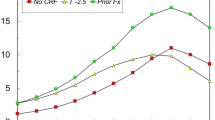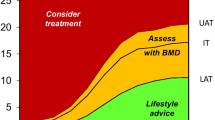Abstract
In its first decade, the goals of the Geisinger Health System Osteoporosis Program at its inception were to increase awareness, diagnosis, and treatment of osteoporosis and to monitor predefined outcomes. The program was innovative in that it crossed specialties and regions and used guidelines in an effective manner. In addition, success in reducing hip fracture and cost were demonstrated, and it remains one of the few programs today that has done so, as reported by Newman et al. (Osteoporos Int 14:146–151, 2003). The osteoporosis program has now moved from a provider and allied provider empowerment focus to reorganizing our thoughts about how to best manage osteoporosis care across our healthcare system by defining and acting on four major osteoporosis care gaps: (1) at-risk patients do not get tested, (2) tested patients are not accurately risk assessed, (3) high-risk patients do not get treated, and (4) treated patients are not adherent. Results of current internal programs and future steps are discussed.


Similar content being viewed by others
References
Newman ED, Ayoub WT, Starkey RH, Diehl JM, Wood GC (2003) Osteoporosis disease management in a rural health care population: hip fracture reduction and reduced costs in postmenopausal women after 5 years. Osteoporos Int 14:146–151
Newman ED, Lloyd T, Starkey R, Conroy P, Horwith M (1998) Osteoporosis clinical practice guideline. Penn State Geisinger Health System
Newman ED, Starkey RH, Ayoub W, Davis C, Diehl J, Hanus P, Wood CG, Frey C (2000) Osteoporosis disease management: best practices from the Penn State Geisinger Health System. J Clin Outcomes Manage 7(5):23–28
Newman ED, Hanus P (2001) Improved bone health behavior using community pharmacists as educators: the Geisinger Health System Community Pharmacist Osteoporosis Education Program. Dis Manag Health Outcome 9(6):329–335
Newman ED, Matzko CK, Olenginski TP, Perruquet JL, Harrington TM, Maloney-Saxon G, Culp T, Wood GC (2006) Glucocorticoid-Induced Osteoporosis Program (GIOP): a novel, comprehensive, and highly successful care program with improved outcomes at 1 year. Osteoporos Int 17:1428–1434
Newman ED, Olenginski TP, Perruquet JL, Hummel J, Indeck C, Wood GC (2004) Using mobile DXA to improve access to osteoporosis care. J Clin Densitom 7:71–75
Newman A, Bloom K (2008) Closing the osteoporosis quality care gap using an electronic health record health maintenance reminder: significant improvement in DXA testing in women over 65. Arthritis Rheum 58:S748
Newman ED, Fernandez J, Olenginski T, Lentz M, et al. (2009) Closing osteoporosis care gaps through process redesign: the Primary Care–Rheumatology DXA Partnership. A&R 60(10) (suppl): S714
Oppermann B, Ayoub W, Newman E et al (2010) Consultative DXA reporting improves guideline-driven quality of care. J Clin Densitom 13(3):315–319
Olenginski T, Maloney-Saxon G, Reardon J, Oppermann B, Morris S, Ledwich L, Newman ED (2009) High Risk Osteoporosis Clinic (HiROC)—closing the loop in clinical osteoporosis care. A&R, 60(10) (suppl): S114
Acknowledgments
While our osteoporosis program has involved scores of individuals, a few key people should be acknowledged for their energy, ideas, and dedication: Ralph Starkey, MD (early program development and leadership); Jennifer (Hummel) Fernandez, RT (Mobile DXA Program); Cynthia Matzko, RN MSN (GIOP Program); Gwynne Maloney-Saxon, RN MS (HiROC Program); Thomas Olenginski, MD; and William Ayoub, MD (multiple seminal contributions throughout the program's existence). These individuals have dedicated significant professional and personal time, energy, expertise, and creativity with a single goal in mind—improving the health care of those we serve—our patients.
Conflicts of interest
None.
Author information
Authors and Affiliations
Corresponding author
Additional information
An erratum to this article can be found at http://dx.doi.org/10.1007/s00198-011-1760-5
Rights and permissions
About this article
Cite this article
Newman, E.D. Perspectives on pre-fracture intervention strategies: the Geisinger Health System Osteoporosis Program. Osteoporos Int 22 (Suppl 3), 451 (2011). https://doi.org/10.1007/s00198-011-1695-x
Received:
Accepted:
Published:
DOI: https://doi.org/10.1007/s00198-011-1695-x




